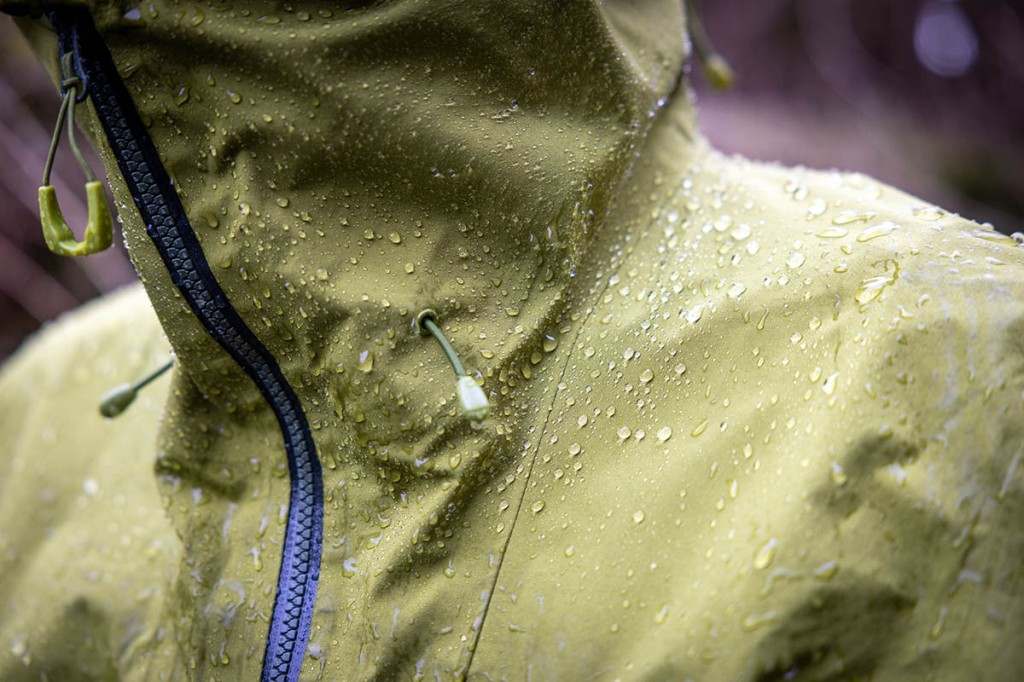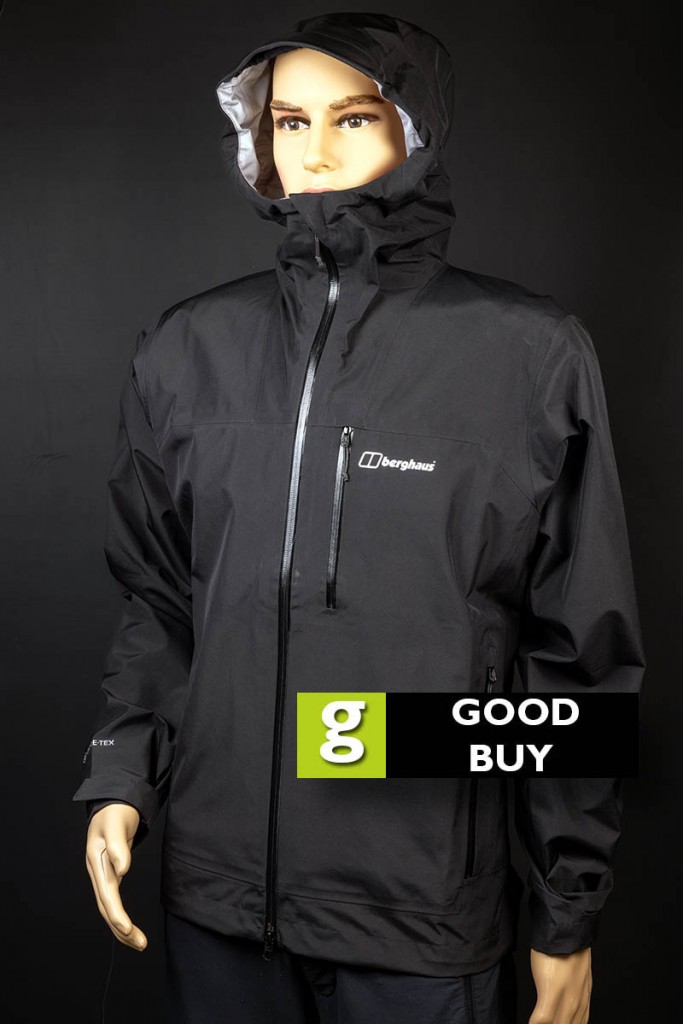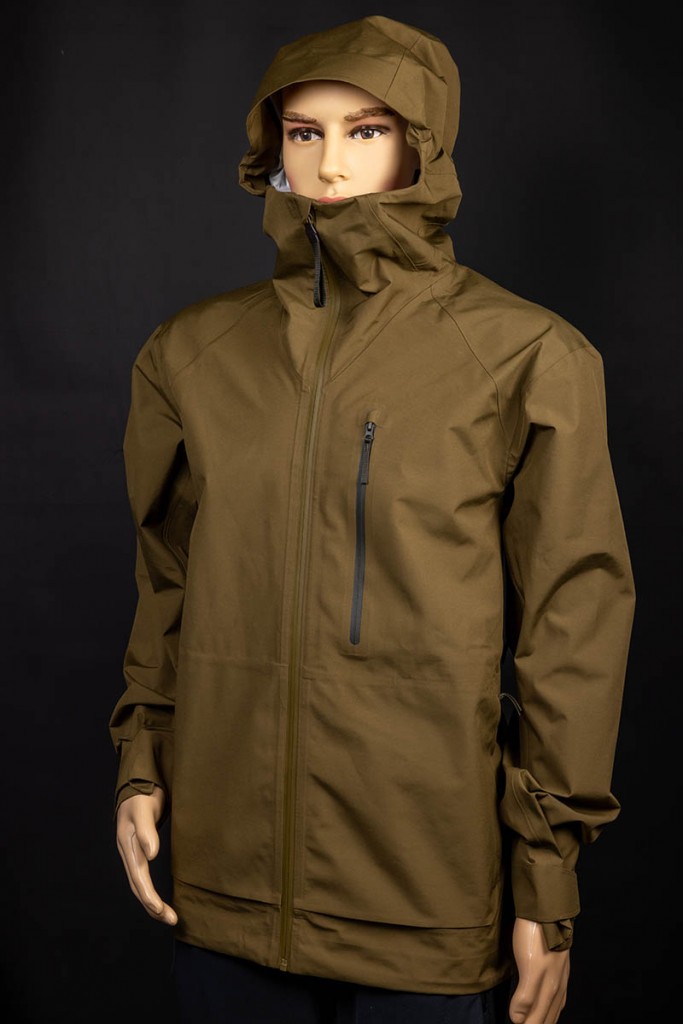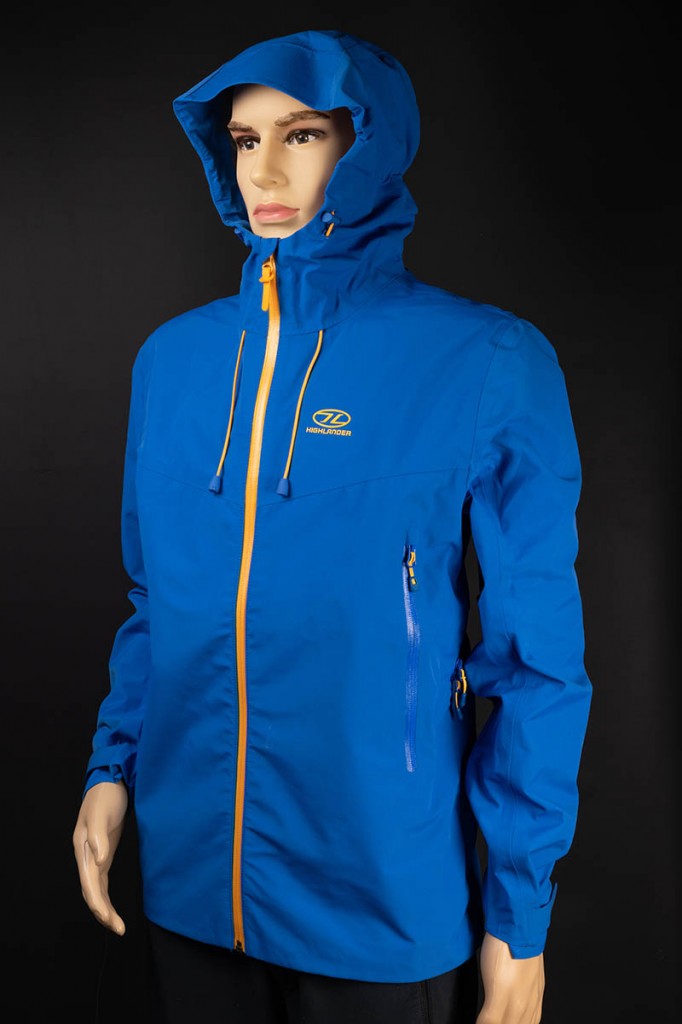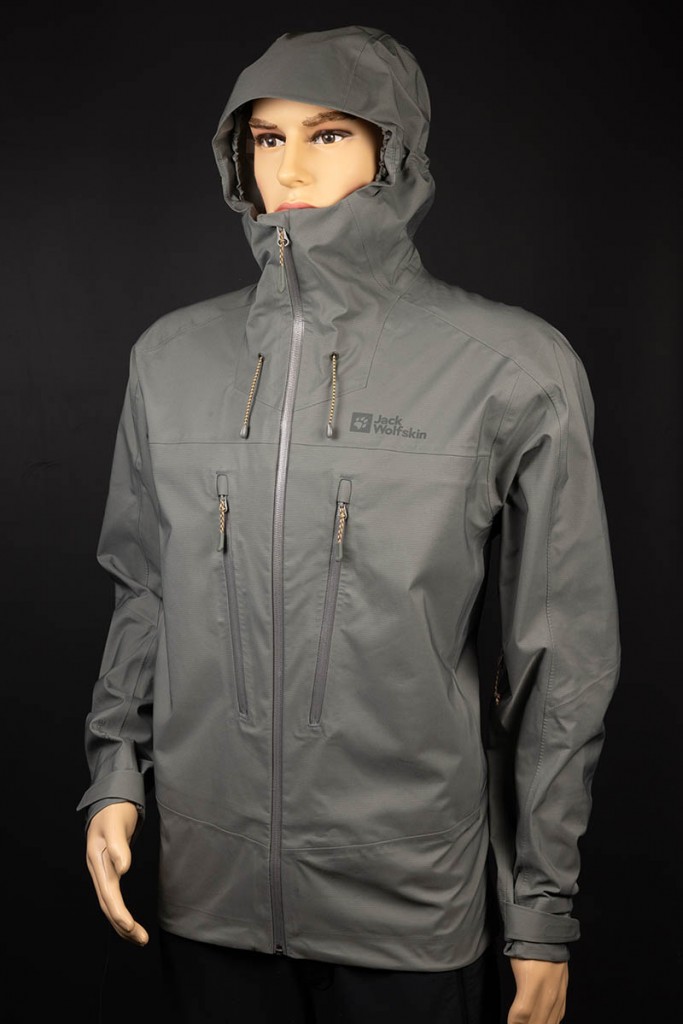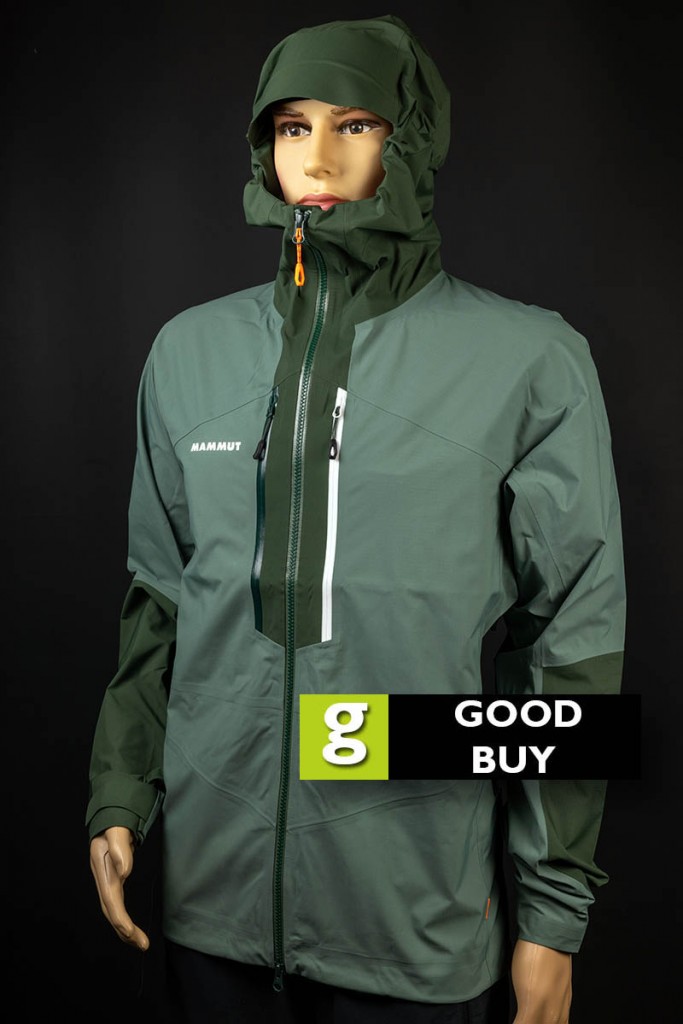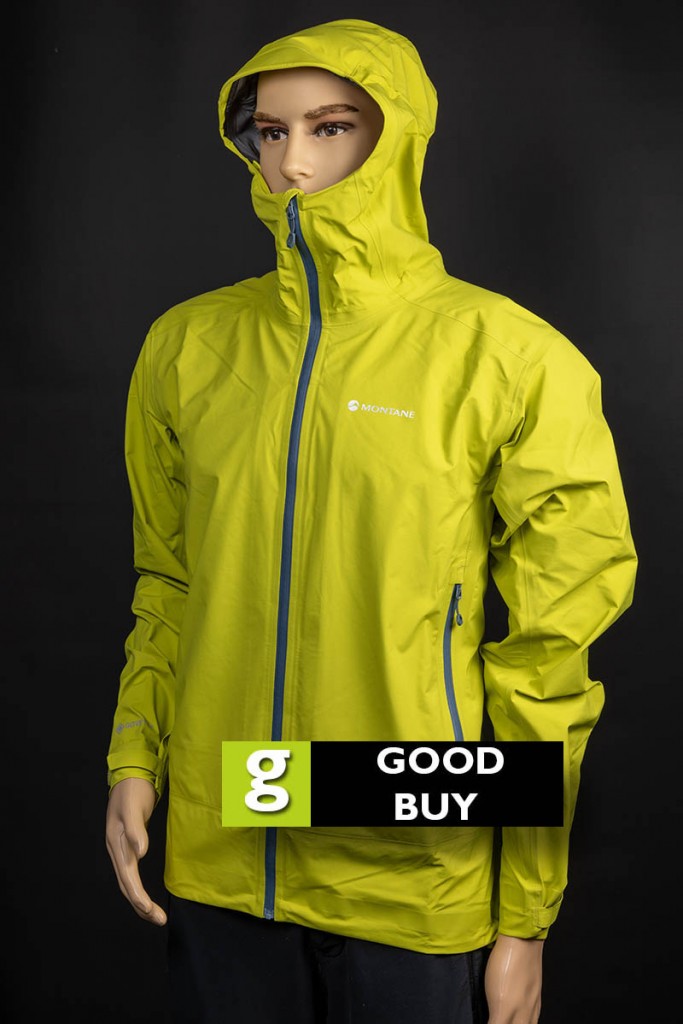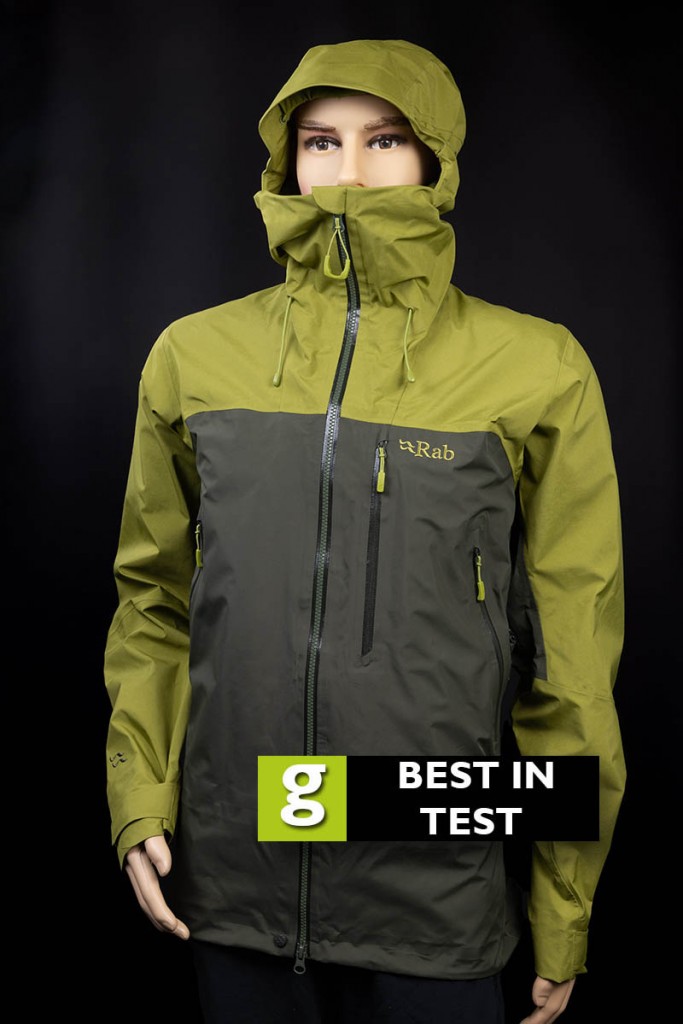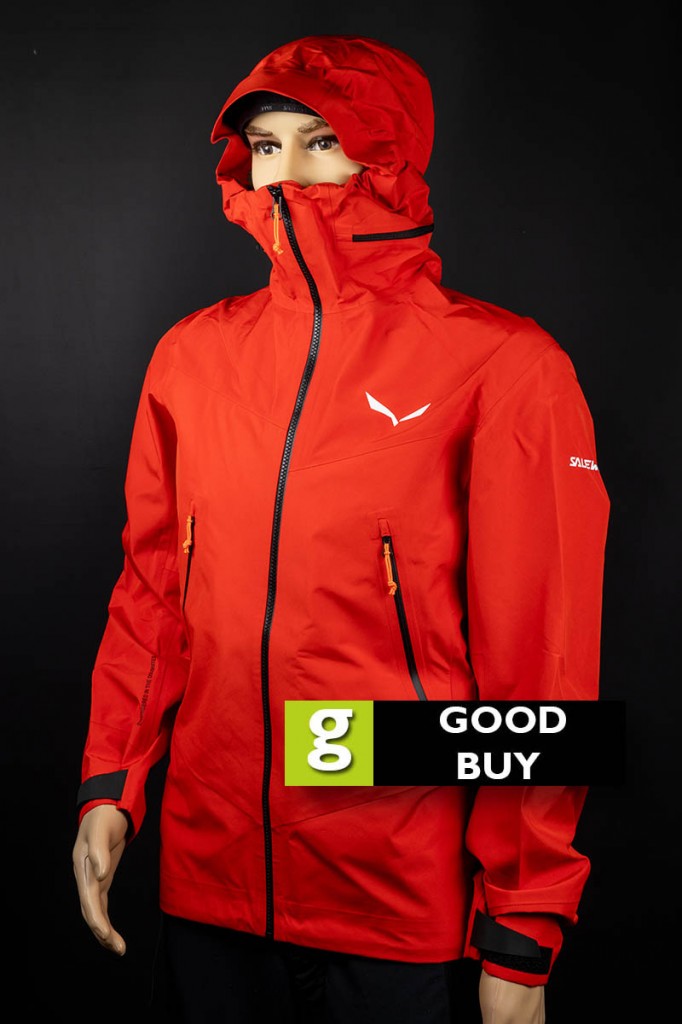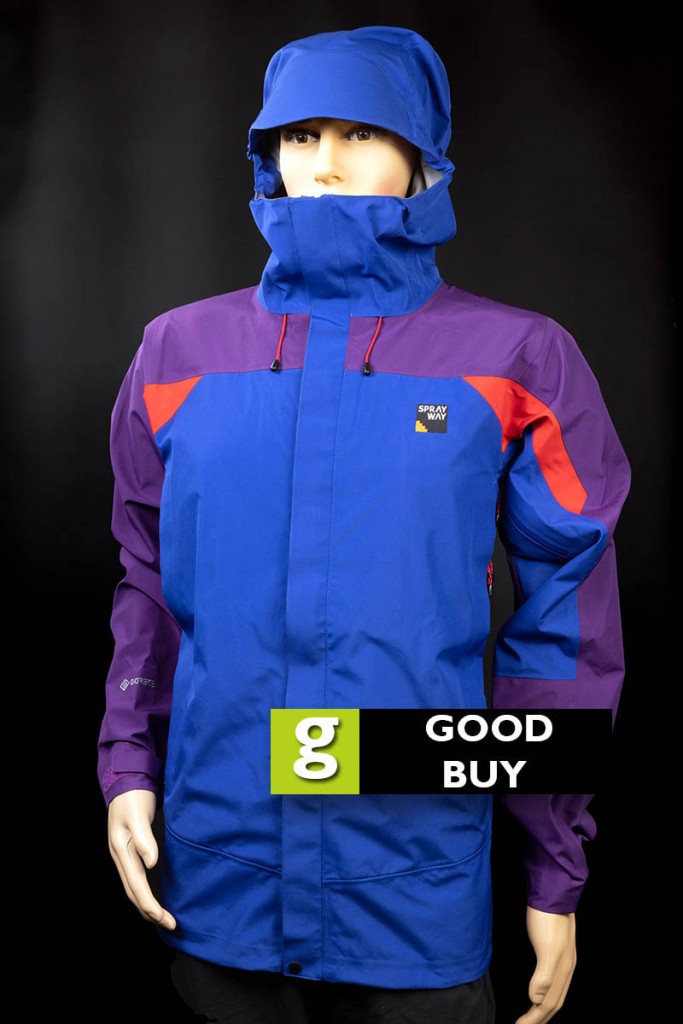Along with a good pair of walking boots, I rate a waterproof jacket as one of the two essentials if you’re heading for the hills in the UK.
We live in a maritime climate, our islands surrounded by water, and the days on which you can be guaranteed free of the risk of being rained on are few and far between.
The jackets reviewed here are shell jackets – designed to be the outer layer of a system that, depending on the weather, will include a base layer and mid-layer, perhaps even an extra layer when things get really cold.
Although there are other ways of keeping out the rain and snow, all of the test jackets use the conventional method of an impermeable waterproof membrane bonded to a fabric treated to repel water. This ‘durable water-resistant’ treatment, despite its name, will wear off in time, sometimes in quite a short time, and the jacket will need re-treating either with wash-in liquids or spray-on chemicals. Sometimes subjecting the garment to gentle heat will also bring the DWR treatment back to life. Waterproof membranes can get clogged up by oils secreted in sweat, so regular washing using the appropriate cleaner will help keep their performance up to scratch.
Conventional membranes, including the best known Gore-Tex, have for years been made from PTFE, a fluoride-containing material that has microscopic pores that allow perspiration to escape outwards but block the larger rain molecules. DWR treatments also contained fluorocarbons, initially long-chain C8 chemicals then latterly C6 versions, containing fewer carbon atoms. They work by lowering the surface tension of the fabric, hence the ‘beading’ you see on the waterproof garments.
Stopping the outer fabric wetting out enables better transmission outwards of perspiration, or breathability as it’s known in outdoor gear. But fluorocarbons – the ‘forever chemicals’ – are viewed as bad for the environment and for the body, hence the move from C8 to the less harmful but also less effective C6 treatments.
Many brands are moving to treatments that are free of perfluorochemicals though some continue to use C6 PFCs in their high-performance waterproofs. Gore-Tex has recently introduced an expanded polyethylene membrane that doesn’t use PTFE or any other fluoro-chemical.
The ‘waterproofness’ of a fabric is measured by its hydrostatic head. This is a laboratory rating that involves subjecting a circle of the material to increasing water pressure until it leaks. The result is rated in millimetres, so a jacket with 20,000mm HH will resist the equivalent of a water column 20m high! The minimum HH to qualify as waterproof is 5,000mm but for serious outdoor-activity use I’d be looking at something from 10,000mm upwards and in winter even higher, as wind-driven rain presents a real test for waterproof jackets. Even with the best performing waterproofs, you’ll still get damp if you’re active as, in my experience, even the jackets with the top breathability ratings can’t shift perspiration quickly enough if you’re working hard on a mountain ascent, especially when the ambient temperature on the hill is low.
All of the jackets in this test were evaluated during winter months in conditions that included heavy rain, strong winds, snow and occasionally hail.
We’ve rated them for their performance: how well they kept out the weather; overall comfort, including how well they dealt with perspiration; the perceived quality of the design and production; how they represent value for money; and a sustainability score both for the garment and the environmental values and actions of the company behind it.
Berghaus Vorlich 3L GTX Jacket
Price: £300
Colour: black
Weight: 466g
Material: polyester
Waterproofing: Gore-Tex
Country of manufacture: Vietnam
Women’s version: yes
Size: S-XXL men’s; women’s 8-16
Recommended wash: 30C non-biological, low tumble dry, cool iron
The Vorlich is the top of the range of three new additions to Berghaus’s waterproof jacket collection for this season and uses Gore-Tex’s PTFE membrane for its main waterproofing.
The design is clean, and the cut falls somewhere between athletic and relaxed, with its length fairly short. The fabric feels robust and is of medium stiffness though the polyester outer shell has quite a soft feel.
The main, water-resistant zip has a baffle behind it for extra protection and it has double pullers, useful when you want to undo the lower part of the jacket to deal with, say, inner layers. There are two hip pockets and one chest pocket, all with water-resistant zips. The latter is big enough to take a smartphone. All the pullers except the secondary one on the main zip have short cord extensions, which helped when using the zips while wearing gloves.
The jacket’s hem has twin shockcord adjusters with spring toggles to cinch in the bottom of the jacket in strong winds. The sleeves have hook-and-loop adjustment at the cuffs, which were wide enough to fit over winter gloves.
The hood has a stiffened, wired peak and just a single rear halo-type adjuster, which did cinch the fabric quite well around the face, despite there being no front adjustment. The hood turned well with the head when properly adjusted, and there’s a narrow chin guard of microfleece material, which helped a little comfort. The hood was just big enough, when slackened, to wear over my climbing helmet but it was a snug fit.
The Vorlich is pretty minimalist in design; there are no pit zips for instance and it was placed in the middle of the weight table for jackets in the test.
Out on the hill in some pretty wet and windy weather, it worked well. It provided assured protection, keeping me dry in gales and torrential rain. The two main pockets are placed where a rucksack hip belt crosses, which made them difficult to use without unfastening the belt – not ideal. The hood stayed in place in strong headwinds and kept most of the rain out during this frontal assault.
The fabric stood up well during testing and resisted abrasion.
I liked the cut of the Berghaus jacket, which provided just the right balance between space for winter layers and a snug fit to keep out the weather. The Vorlich felt at home on the hill in typical British winter weather: wet, windy and cold. Packability of the jacket was reasonable too, not taking up too much space in my rucksack.
The jacket’s durable water-resistant treatment is PFC-free. Berghaus operates a free repair scheme for its garments – the customer pays the cost of returning the item to the brand’s Sunderland Repairhaus base.
The company is also working with Eden Reforestation to plant two million trees a year in its quest to reach net-zero by 2030. It was certified as a B Corp company in 2022, a measure of environmental and social responsibility. Of its clothing styles in 2021, 57 per cent were ‘Made Kinder’, meaning more than 50 per cent of their of their content is bio-based or recycled, more than 90 per cent is blueseign approved or is made with certified responsible cotton or sustainable down.
Berghaus is a member of the Sustainable Apparel Coalition and uses 100 per cent renewable energy at its headquarters. The company has donated £35,000 to three UK environmental schemes.
Best uses: mountain walking, mountaineering, hillwalking, country walking.
Performance 35/40
Comfort 24/30
Quality 7/10
Value for money 7/10
Sustainability 8/10
Total score: 81/100
H&M 3-Layer StormMove
Price: £139.99
Colour: green
Weight: 588g
Material: 66 per cent polyester; 21 per cent polyamide; 13 per cent polyurethane
Waterproofing: StormMove
Country of manufacture: China
Women’s version: yes
Size: men’s XS-XXL; women’s XS-XL
Recommended wash: 40C, no fabric conditioner
The Swedish brand is better known for its mainstream fashion clothing, so it was interesting to put the StormMove to the test to see how it compared with more established outdoors brands.
The first thing to say is that the H&M jacket has all the features you’d expect to see on a waterproof aimed at hillwalkers.
There are two zipped hip pockets and a single zipped chest pocket. The latter has a mesh lining and all have short extensions to their zip pullers to make them easier to use when wearing gloves. The hip pockets have storm flap covers. As with many of the jackets, they’re placed at the area where a hip belt crosses the body, so are difficult to use when wearing a rucksack.
The StormMove has good length pit zips with a single puller. These allowed some venting to help shift the build-up of moisture within the garment. The jacket’s hem has shockcord adjustment with a twin tethered spring toggle arrangement.
The main zip is backed by a storm flap, but has only a single puller, so less handy for accessing inner layers.
The fabric is quite stiff and felt robust. Fit is standard. Sizing is generous – close to a size above average.
The sleeves have hook-and-loop strips for cuff adjustment. The cuffs were wide enough to allow winter gloves to be tucked inside them to help keep out the rain.
The hood is on the small side. It has a double-thickness peak, with very little stiffening, and moved in high winds. Rear halo volume adjustment has spring-toggle locking for its shockcord, which is under a little cowl, making it awkward to reach and adjust while wearing gloves. Front adjustment of the hood is by twin shockcords inside the top of the jacket, meaning you have to unzip it a little to get at them. Concealed spring buttons lock the cords in place. Tightening the rear halo cord tended to pull the hood back from the face, so I found it better to cinch the hood in mainly using the front adjusters around the face. There’s a narrow chin guard strip at the top of the main zip’s storm flap, which helped a little with comfort.
The StormMove jacket did what was asked of it while out on the hill. It kept out the rain, and provided quite good breathability. H&M’s figures rate its waterproofing at 24,000mm hydrostatic head and breathability at 15,000g/m2/24h, which were pretty much borne out during testing. All the seams are taped and the design allowed for good movement while reaching up on more technical ground. Fit is standard rather than athletic and, as mentioned, sizing was generous, so I’d advise trying the H&M jacket on before purchase.
Sustainability is good. The jacket is made from 66 per cent recycled polyester and 21 per cent recycled polyamide. The former comes either from PET bottles or recovered textile waste; the recycled element of the polyamide also comes from reprocessed textiles. The H&M group has set a target of becoming net zero by 2040.
It says it is improving its products to make them last longer and easier to recycle.
H&M has invested in a windfarm in Bangladesh to improve the availability of renewable energy. In the latest published report, the company said its use of recycled materials increased from 18 per cent to 23 per cent. The brand says 84 per cent of its commercial goods have recycled or other more sustainably sourced materials. It has retrofitted LED lighting in three-quarters of its stores and is working to retrofit efficient heating, ventilation and air conditioning. It has a target of using only recycled polyester rather than virgin versions by 2025.
H&M says its tests indicate the StormMove jacket performance meets that of leading outdoor brands, and our testing supported that to a large degree, with the jacket keeping out heavy rain and offering pretty good breathability. The design follows outdoor gear norms, with perhaps just a hint of Scandinavian or High Street styling. All the features I’d look for in a waterproof shell jacket are there.
The big selling point for the H&M jacket is its selling price, making it an interesting prospect for buyers wanting full weather protection at a competitive rate. I found the fabric stiff and rustly, but overall comfort was good. It’s not the best choice for an athletic fit: its style is relaxed and the length is generous. The sizing allowed good layering of clothing under the jacket.
Best uses: mountain walking, hillwalking, country walking, urban use.
Performance 35/40
Comfort 21/30
Quality 7/10
Value for money 8/10
Sustainability 8/10
Total score: 79/100
Highlander Munro Jacket
Price: £150
Colour: blue
Weight: 596g
Material: nylon
Waterproofing: Prot3X
Country of manufacture: Not stated
Women’s version: no
Size: XS-XXL
Recommended wash: Nikwax Tech Wash 30C
The Munro is this Scotland-based brand’s top mountain jacket.
The cut is standard, with a medium length. The fabric feels robust and isn’t too stiff and rustly. The Munro uses Highlander’s Prot3X waterproof membrane, which is rated at a respectable 20,000mm hydrostatic head. On one outing during one of our many named storms this winter it kept the rain out during heavy, gale-swept rain.
The main zip has a single puller and is backed by a storm flap. It lacks a chin guard but comfort was reasonable when the zip was fully fastened and the hood cinched in against the wind. The hem is adjustable via a shockcord with twin spring toggles to lock it.
There are two zipped chest pockets. These are a good size, big enough to take an OS map. Inside the jacket is a smaller, zipped pocket, which accommodated my smartphone.
The Munro has pit zips with twin pullers, which made adjustment easier. They did allow some ventilation during milder days, which helped shift perspiration build-up.
The sleeves have short cowls at the cuffs to extend a little way over the hands, and the cuffs have a hook-and-loop tab to adjust them. The cuffs were not quite wide enough to allow thick winter gloves to be slotted inside them. The hood has a stiffened peak and is adjustable by both a halo rear shockcord and twin front face shockcords, all with spring toggles for locking. The hood worked well, staying in place in very strong headwinds and also allowing easy turning of the head. It was just big enough to use while wearing my climbing helmet, but the fit was very snug.
I wore the Munro in some pretty filthy weather, with high winds and driven rain, and the jacket kept the rain out. Breathability is rated at 15,000g/m2, a fairly respectable figure for a jacket at this price, and the Highlander did quite a good job at shifting the interior damp on quite cold, wet days, the most testing time for a waterproof.
The Munro jacket is a proper three-layer waterproof at a competitive price. The fabric did its job and felt robust; all the seams are taped and it has all the features you’d expect in a garment designed for hill and mountain use. The design is clean and the material isn’t too stiff, but here’s no female-specific version of the jacket.
Highlander doesn’t provide any sustainability information about the Munro jacket, nor about the company generally. The garment was robust and good quality, which indicates it should be durable, a key factor towards sustainability.
The Munro represents good value of money. It has all the features needed for hillwalking in winter and performed well, all at a competitive price. It may not have the sexy logos of the top brands, but it’s a well designed jacket that will keep you protected in the UK weather.
Best uses: mountain walking; hillwalking; country walking; urban use.
Performance 35/40
Comfort 23/30
Quality 7/10
Value for money 9/10
Sustainability 4/10
Total score: 78/100
Jack Wolfskin Kammweg 3L Jacket
Price: £430
Colour: grey-green
Weight: 520g
Material: 87 per cent polyester; 13 per cent polyurethane
Waterproofing: Texapore Ecosphere Pro
Country of manufacture: Vietnam
Women’s version: yes
Size: S-XXXL men’s; women’s XS-XL
Recommended wash: 30C
The Jack Wolfskin jacket uses Ecosphere Pro Schoeller fabric, which has a fairly soft feel.
The three-layer construction has the brand’s own Texapore waterproof membrane, which has a rating of 20,000mm hydrostatic head. The fit is standard, and length is standard too. Sizing was quite generous, with plenty of room for layers.
The main, water-resistant zip is backed by a storm flap and there’s a short chin guard for comfort. The zip has a single puller and a press-stud fastener at the base. The hem has a shockcord to cinch it in, with twin spring toggle fasteners.
The sleeves are slightly articulated and the cuffs have hook-and-loop adjustment tabs. The cuffs were just wide enough to get my winter gloves inside, but it was a struggle. I try to tuck gloves under the cuffs in heavy rain as this lessens the chance of water running down the outside of the sleeve and into the glove.
The Kammweg jacket has two zipped chest pockets. These are a good size, big enough for a map, and mesh lined. They’re sited above the area of the hipbelt, so were easier to access than on some jackets. Inside the jacket there’s another, smaller zipped pocket, big enough for a smartphone.
The hood worked well, though the peak has very little stiffening, which meant it flapped up a little in strong winds. There’s rear halo adjustment via a shockcord with spring toggle. This is housed in a little cowl which made adjustment tricky when wearing thick gloves. At the front, twin shockcords with hidden spring buttons allow the hood to be tightened into the face.
The outer face of the Jack Wolfskin beaded rain initially, but in very heavy rain the garment wetted out. It didn’t let the weather in, but felt clammy compared to other jackets in the test and I felt this hindered breathability to some degree.
The sleeves have short, zipped pit zips with a single puller which helped vent the jacket.
Freedom of movement in the jacket was good, and it accommodated a couple of winter layers underneath with no problem. Windblocking was very good.
Sustainability of the jacket was good. The Texapore Ecosphere Pro membrane is made completely from recycled material – from left-over production remnants. The outer fabric has content from recycled PET bottles and the durable water resistant treatment is fluorocarbon-free. The jacket’s lining is 100 per cent recycled material.
Jack Wolfskin is a member of the Sustainable Apparel Coalition. It arranges wastewater tests at its production sites to monitor compliance with the Zero Discharge of Hazardous Chemicals scheme. It has reduced its use of airfreight and 90 per cent of its incoming freight globally is by sea, reducing overall CO2 emissions.
Staff are encouraged to use train travel in preference to air travel for trips within Germany and neighbouring countries, and company bicycles and power-assisted bikes are available to staff for short journeys. The company has pledged to reach science-based targets for greenhouse gas emissions by 2030.
The Kammweg 3L Jacket is good quality but comes with a fairly hefty price tag.
Best uses: mountain walking; hillwalking; country walking; urban use.
Performance 33/40
Comfort 22/30
Quality 7/10
Value for money 6/10
Sustainability 8/10
Total score: 76/100
Mammut Taiss HS Hooded Jacket
Price: £335
Colour: green
Weight: 425g
Material: polyamide with polyester lining
Waterproofing: Mammut DRYtechnology
Country of manufacture: Vietnam
Women’s version: yes
Size: S-XXL men’s; women’s XS-XL
Recommended wash: 30C, wash inside-out, tumble-dry for 20 minutes or cool iron to reactivate DWR
The Taiss jacket is medium length and a cut somewhere between standard and athletic.
It uses the brand’s own DRYtechnology waterproofing and Mammut says it is rated at an impressive 27,000mm hydrostatic head. The 30 denier fabric isn’t particularly stiff and the Taiss is among the lightest of the jackets in the test, though there didn’t seem to be any compromise on its robustness.
The main zip has two pullers, useful for adjusting inner layers or trousers, and is backed by a storm flap. There’s a short, narrow chin guard at the top.
The hem is adjustable via a shockcord with twin spring button fasteners. The sleeves are articulated and have hook-and-loop tabs for adjustment at the cuffs. They were just wide enough to allow winter gloves to be slipped into the cuffs. Two long pit zips run from mid forearm to waist level, and have twin pullers, making them adjustable from either end. These provided good ventilation on milder days.
There are two zipped chest pockets which are a good size, just big enough to take an OS map. The left zip is in a contrasting white colour. Inside the jacket is a small, zipped pocket but this is very small – not big enough to take my smartphone, but large enough for my compass.
The hood is quite big, big enough to wear over my climbing helmet. There’s just one adjuster, a rear halo shockcord. The hood stayed up in headwinds and was pretty snug around the face. The peak is stiffened and there’s an elasticated mesh panel underneath it, which helped form a good seal around the face. The hood turned well with the head when cinched in. When using the hood with the jacket fully zipped up, the garment came quite high on the face, covering my mouth.
The Mammut jacket worked well on the hill, keeping out persistent, wind-driven rain and providing very good breathability. Windblocking was also very good and mobility was good while wearing the jacket. The chest pockets sit above the rucksack hipbelt area, making them easier to access.
The Taiss HS Hooded Jacket stood up to testing well, and felt up to the job of protecting me from the elements in some pretty foul weather on the hills.
The Mammut jacket has PFC-free durable water resistant treatment. The company has a goal of using 95 per cent recycled PET in all its polyester products by 2025. In the latest reporting year, 57 per cent of its clothing products were bluesign certified, a system guaranteeing safer and more sustainable processes. The brand aims to have 90 per cent of its products bluesign certified by 2025. It also aims to have all its products PFC free by that year. In 2022, 85 per cent of its clothing and 94 per cent of its rucksack had no perfluorinated compounds.
Mammut’s Swiss headquarters are powered entirely by hydroelectricity and its German stores and warehouse use only renewable electricity. Only 5 per cent of its freight movement is by air, and it has plans to move more production to Europe, reducing its carbon footprint. It has an agreement with Climeworks and Klimate to remove 50,000 tonnes of CO2 from its emissions.
The Mammut Taiss HS Hooded Jacket had a quality feel and performed well, with good protection from wind and rain and very good breathability, even on cold, wet days.
Best uses: mountain walking; hillwalking; mountaineering; country walking..
Performance 35/40
Comfort 24/30
Quality 8/10
Value for money 7/10
Sustainability 8/10
Total score: 82/100
Montane Phase Lite Jacket
Price: £325
Colour: green
Weight: 309g
Material: nylon
Waterproofing: Gore-Tex Active
Country of manufacture: Bangladesh
Women’s version: yes
Size: S-XXL men’s; women’s 8-16
Recommended wash: 40C
The Phase Lite, as the name suggests, is the lightest jacket in the test and is firmly aimed at users who like to move quickly in the hills.
The Montane garment uses 30 denier nylon and Gore-Tex’s Active membrane to provide waterproofing. It’s very packable, easily fitting into my 3-litre drysack.
The material was one of the less rustly ones in the test and the jacket doesn’t have that stiffness that some of the heavier, full-on jackets have. Design is fairly minimalist, and the fit is pretty athletic, in keeping with the Phase Lite’s intended use.
The main, water-resistant zip has a storm flap backer and there’s a press stud fastener at its base. The zip has a single puller. There’s a narrow tricot chin guard for comfort. There are no pit zips.
The jacket’s hem has shockcord adjustment with twin spring toggles, allowing it to be cinched in to keep out updraughts.
The sleeves have hook-and-loop strips for adjustment at the cuffs. They were flared just enough to allow thick winter gloves to be slotted under them, but it was a snug fit.
There are two zipped chest pockets that sit partly in the hipbelt and harness position. These are a good size, big enough to take an OS map, and the lining is fine mesh, which helped breathability in that area.
The hood was big enough, just, to accommodate my climbing helmet, but it was very snug. Adjustment is via a rear halo shockcord with spring-toggle fastening, plus front cords with buried spring-button fastening. The ends of the front cords sit inside the jacket, so you have to undo the zip a little to get to them, but once adjusted, they sit out of the way inside the garment. I found it easy to get a good fit around my face to keep out wind-blown rain using both the front and rear adjusters. The hood turned well with the head when cinched in. The peak is stiffened and wired, helping get a good position against wind and wet.
Any doubts that such a lightweight jacket would struggle to keep out the weather were dispelled during testing. The waterproofing worked well, even in sustained wind-blown heavy rain. Breathability was good too – important in a jacket designed to be worn when pushing the pace.
The light construction of the Montane jacket was a distinct advantage for me when I wanted to keep the weight down and up the pace while out on the hills. Mobility while wearing the Phase Lite was good.
The Phase Lite’s robustness indicates it should, with care, last for many outings into the hills and countryside. The garment is bluesign approved but does use short-chain PFCs in its durable water repellency and the Gore-Tex membrane also uses fluorocarbons. The jacket does not contain any lower-impact materials. Montane offers a limited repair service for items such as the zip puller, press-stud and cuff hook-and-loop strips.
It offers electric car-charging points at its sites and its leased cars are electric or hybrid. It promotes employees’ cycling to work and also allows one-day homeworking to reduce commuting. It uses renewable energy at its sites.
It says its design principles ensure there is both physical and aesthetic durability, rather than pursing passing trends. Its Montane Repurposed scheme, offering repaired and returned items, will be expanded this year. It supports, among other organisations, the European Outdoor Conservation Association, Fix the Fells, Moors for the Future Partnership and the Tyne Rivers Trust. Its factories work within the Fair Wear Foundation principles.
It has increased the use of recycled materials in its baselayers and synthetic insulation. At present, 34 per cent of the brand’s styles use either a C6 DWR or PFC-based membrane, or both, but 30 per cent of its products use a PFC-free DWR. Overall, 47 per cent of its styles that have DWR use PFC-free versions.
It uses 100 per cent recycled LDPE bags to deliver its products, and all direct-to-consumer deliveries have no poly bags. Montane has reduced its use of air freight by nine per cent.
The notion might be that a lightweight waterproof is really only good for summer activities but the Montane jacket demonstrated that such a garment can provide the protection needed in winter conditions, while allowing rapid movement on the hills.
Best uses: mountain walking; hillwalking; trail running, mountaineering.
Performance 35/40
Comfort 24/30
Quality 7/10
Value for money 7/10
Sustainability 7/10
Total score: 80/100
Rab Latok Mountain GTX Jacket
Price: £480
Colour: green
Weight: 500g
Material: polyamide
Waterproofing: Gore-Tex Pro Most Breathable
Country of manufacture: China
Women’s version: yes
Size: S-XXL men’s; women’s 8-16
Recommended wash: 30C non-biological liquid detergent or pure soap; tumble-dry for 20 minutes or warm iron to reactivate DWR
This jacket is part of Rab’s top-of-the-range Latok collection and comes with a price tag to match.
It uses Gore-Tex’s Pro material, the brand’s ‘gold standard’ waterproofing, which is aimed at outdoors professionals and high-frequency users of waterproof jackets. Never ones to keep things simple, Gore makes three versions of its Pro fabric: Most Rugged, Stretch and Most Breathable. This Rab jacket uses the last of these to provide the best possible breathability in a still rugged fabric.
Rab uses two different thicknesses of the polyamide fabric: 80 denier and 40 denier in zones, with the tougher material on the shoulders and sleeves, to protect against abrasion by rucksack straps, and the lighter fabric in the core of the jacket to give less bulk and better mobility.
The Gore-Tex Pro also has a new backing material that is dope-dyed, with pigment added before the first stage of the polymer production, leading to a much reduced, about 50 per cent, water consumption compared to that found in conventional dyeing. The backer has a micro-mesh pattern adding to its durability.
Out on the hill, the Latok Mountain GTX jacket certainly has a robust feel. There’s some rustling, but it’s not excessive and there is a bombproof feel to the protection it gives.
The main zip has a storm flap backing and twin pullers, the main, top one having good-size cord loop and plastic overlay which was easy to use while wearing gloves. There’s a press-stud fastener at the base of the zip and the top section has a tricot chin guard strip.
The hem of the jacket has shock cord adjustment with twin, slightly oversized spring toggles which again were easy to use with gloves. The sleeves are articulated and the cuffs have short extensions to cover the back of the hands. The cuffs flare enough to fit over winter gloves and have hook-and-loop strips for adjustment. There are long pit zips which allowed a good amount of venting. The zips have double pullers, the bottom one having a cord extension and the top one a plastic tab, so you quickly know which is which if you’re adjusting them.
There are twin pockets on the Latok, placed just above the hip belt area. The zip pullers have plastic tabs. These two pockets are a good size, big enough to take an OS map. A third, smaller chest pocket is easily big enough to take a smartphone. It also contains a short webbing strap with plastic hook, to which you can attach your keys or compass. Inside the jacket is another zipped pocket with stretch lining. This again is big enough to accommodate a smartphone.
The hood worked well, with the rear halo cord cinching in the volume well, and with an easily adjustable spring toggle. The front adjustment has two shock cords with buried spring button fasteners and the peak is stiffened and wired, all making it possible to get a good seal around the face to help resist headwinds. The hood turned well with the head and, when the jacket was fully zipped up and the hood cinched in, covered the mouth. The hood was big enough to use fully while wearing my climbing helmet. When not in use, the hood can be rolled up and secured in place via a tab with hook-and-loop strips.
The garment contains 19 per cent overall recycled material. The Gore-Tex membrane and the durable water-resistant treatment both use fluorocarbons though overall, 80 per cent of the brand’s products are fluorocarbon-free this season. The parent company Equip Outdoor Technologies UK says its products will be fluorocarbon-free by the autumn-winter 2024 season, including its first Gore-Tex jacket without the chemicals, launched this season.
Rab has opened service centres in the UK, Netherlands, USA and Canada, with 15,000 products repaired and restored and in the UK, it offers a rental service for high-end items for one-off trips and expeditions.
Equip has a target of reducing greenhouse gas emissions by 42 per cent by 2030 and has reduced CO2 emissions per product by 17.6 per cent. It has been climate-neutral, via carbon credits, since 2020. It is working with the European Outdoor Group to introduce a system for collecting and recycling polythene bags which would otherwise be burnt at municipal sites.
The Rab jacket is well designed and quality was good. The robust fabric and useful features made for an assured performance in wet, windy and at times wintry weather during testing. The Latok Mountain GTX should cope with most conditions you’re likely to encounter on the hills and mountains of the UK.
Best uses: mountain walking; winter hillwalking; hillwalking; mountaineering; country walking.
Performance 36/40
Comfort 25/30
Quality 8/10
Value for money 7/10
Sustainability 7/10
Total score: 83/100
Salewa Ortles GTX 3-layer Jacket
Price: £365
Colour: red
Weight: 458g
Material: polyester
Waterproofing: Gore-Tex
Country of manufacture: Bangladesh
Women’s version: yes
Size: XS-XXL men’s; women’s 6-14
Recommended wash: 30C non-biological liquid detergent or pure soap; tumble-dry for 20 minutes or warm iron to reactivate DWR
The Salewa jacket is made using a combination of three-layer Gore-Tex fabric and Gore-Tex Paclite inserts, the latter allowing a decreased weight and better packability. The main material has a woven Gore micro-grid backer.
Its fit is athletic, and the Ortles jacket fits snugly against the body. It has a clean design with just two zipped chest pockets, which sit clear of the hipbelt area. Inside the garment are twin open mesh stretch pockets.
The main zip has a single puller and is backet by a storm flap. There’s a narrow tricot chin guard at the top. When fully closed, the zip and collar cover the mouth.
The sleeves are articulated and the cuffs have hook-and-loop strips for adjustment. The cuffs are wide enough to allow thick winter gloves to be worn inside them. Rather than conventional pit zips, the jacket has vents towards the back of each sleeve. They’re covered by a storm flap which kept the rain from entering quite well. I found the operation of these zips a little trickier than standard pit zips. You have to make sure the sleeve is tensioned by grasping the cuff as you slide the zip puller. There was a tendency for the zip to snag when trying to close it but the vents did work well, with their positioning ensuring no rain got inside the jacket when walking into a headwind.
The hem of the jacket has twin shock cord adjustment with good-sized spring toggle fasteners.
The hood has single adjustment via a rear shock cord that cinches in the hood around the face as well as adjusting volume. There’s a small elasticated panel just under the stiffened peak, which helps keep the hood snug over the forehead. An unusual feature of the hood is its zipped gusset section. Opening the zip that runs along the back of the hood allows it to be expanded for use with a helmet. The zip puller doesn’t have a cord extension so I found I had to take off my gloves to use it. The hood actually accommodated my climbing helmet without opening the gusset, but by doing so I found it much easier to turn the head and look up and down. With or without a helmet, the hood turned well with the head, and the adjustment allowed it to be cinched in close to the face in headwinds.
The Salewa jacket is shorter than some in the test, which made it a good choice for tackling more technical terrain that included sections stepping up. It didn’t ride up while reaching up and, as I mentioned, the cut of the garment is athletic, so check on sizing if you’re planning to wear lots of layers under it.
Out on the hill, the Ortles GTX 3-layer Jacket performed well, providing good waterproofing – it has a 28,000mm hydrostatic head rating – and good breathability. It resisted persistent wind-blown rain and in snowstorms with the PFC-free durable water-resistant treatment holding up well.
Its clean lines and simple design make for nice styling while offering good protection out on the hills and mountains.
The durable water-resistant finish contains no PFAs and the fabric is made from 100 per cent recycled polyester, but the Gore-Tex membranes are made from PTFE. The main fabric is bluesign certified and the jacket is part of the Salewa Committed range, satisfying at least one sustainability criterion in addition to mandatory requirements, namely verified chemicals and factories monitored for social standards.
Salewa operates a repair service for its products and has a number of measures in place to increase sustainability, working with charitable foundation myclimate since 2016, promoting climate protection projects through voluntary compensation payments for CO2 emissions that are unavoidable. The company says its three photovoltaic plants provide more energy than its office and warehouse need, and the excess is fed into the grid. There’s a piping system to store and distribute thermal energy.
It provides its employees with work bicycles and electric scooters and there are free e-bike charging points for customers at its shops. It operates an annual car-free to work scheme.
South Tyrol-based Salewa says the Ortles GTX 3-layer Jacket is suitable for mountaineering and ski touring, but I’d add that it coped well with UK hillwalking and mountain walking and felt robust.
Best uses: mountain walking; hillwalking; mountaineering.
Performance 35/40
Comfort 24/30
Quality 8/10
Value for money 7/10
Sustainability 8/10
Total score: 82/100
Sprayway Torridon Jacket
Price: £375
Colour: blue/purple
Weight: 619g
Material: polyester
Waterproofing: Gore-Tex
Country of manufacture: Ukraine
Women’s version: yes
Size: XS-XXXL men’s; women’s 8-18
Recommended wash: 30C on gentle setting; tumble-dry on low heat
Sprayway has produced its top-of-the-range Torridon for three decades, and this latest version brings it up to date, with recycled polyester fabric and PFC-free durable water-resistant treatment.
There’s a nod to the jacket’s heritage with an inner retro-style label.
Waterproofing comes from a Gore-Tex membrane in the jacket’s three-layer 75 denier construction.
Design is traditional, with a relaxed fit and generous length. The Torridon’s material is robust and fairly stiff and the jacket was the heaviest in the test.
Sprayway has incorporated all the features you’d expect in its ‘pinnacle’ waterproof shell jacket. The main zip has two pullers and is protected by two storm flaps, the outer one being secured to the inner one by a series of short hook-and-loop strips. There’s a press-stud fastener at the base of the zip. At the neck area are twin chin guards.
The hem has shockcord adjustment with good-sized twin spring toggles. The sleeves have hook-and-loop adjustment strip at the cuffs, which are just wide enough to tuck thick winter gloves under. There are also pit zips with two pullers, allowing venting from either the top or bottom. These are a good length and worked well.
The jacket has twin chest pockets, with the zips protected by storm flaps. These are a good size, big enough to take an OS map. Inside these are shock cord adjusters with spring toggles, to cinch in the waist of the jacket at the front. The pocket zips have dual pullers, enabling them to be opened from the top or the bottom, useful if a rucksack hipbelt is obstructing access.
Inside the Torridon, there’s a small, zipped pocket, just big enough to take my smartphone, plus another open-topped stretch mesh pocket.
The hood has a good-sized peak, which is stiffened and wired. There’s rear halo volume adjustment with a shockcord. The spring toggle works well but is under a little cowl, which made it fiddly to operate when wearing thick gloves. Front adjustment was by twin cords that exit to the exterior of the jacket, but have hidden spring toggles. The hood turned well with the head when cinched in, and stayed in place in headwinds, keeping out the driven rain. It was big enough to use while wearing my climbing helmet. The front of the collar covers the bottom part of the face when the jacket is fully zipped up and the hood cinched in. When not in use, the hood can be rolled up and kept in place using a fabric tab with hook-and-loop strips, tucked away in a little pocket inside the jacket.
Out on the hill, the Torridon felt assured and offered good protection. The durable water-resistant treatment held up well and the Gore-Tex membrane ensured no rain got through. The jacket’s breathability was good too.
The 75-denier fabric felt very robust, though it is pretty stiff and a little rustly, the price you pay for a full-on three-layer jacket designed to keep out the worst weather you’re likely to encounter on the UK hills. I had the jacket out in a variety of conditions, from snow to driven rain in gale-force winds, and it performed well.
Its traditional design, building on its long heritage, will appeal to walkers who want a good, colourful jacket in a longer style.
The fabric is PFC-free recycled polyester, though the Gore-Tex membrane is made from PTFE. My Torridon was manufactured in Ukraine, so there were fewer transport miles involved in getting the garment to the UK than one made in East Asia. Outdoor and Sports Company, the parent firm of Sprayway, said it made an early switch from C8 to C6 fluorocarbons for its durable water-resistant treatments and from 2018 switched to PFC-free treatments for its Gore-Tex garments.
The parent company has a restricted substance list which governs their use by factories producing their products.
Best uses: mountain walking; hillwalking; country walking.
Performance 35/40
Comfort 24/30
Quality 7/10
Value for money 7/10
Sustainability 7/10
Total score: 80/100
All the jackets did a good job of keeping the wind, rain and snow out, but the Rab Latok outperformed all the others in terms of performance and comfort, though it was among the most expensive. If you’re going to spend a lot of time on the mountains and hills in all weathers, and if your budget can stretch to it, the Rab jacket would be our recommendation.
Close behind were the Mammut Tais jacket, which was a good all-rounder, and the Salewa Ortles. I liked the simple lines of the latter, which is a good choice for those who like a more athletic fit.
Also in the top ranks was the Berghaus Vorlich, which again had clean lines and simple design, but was cut a little less athletically.
For the athletes on the hill, the Montane jacket is a great choice. Lightweight yet able to keep out the elements, the Phase Lite is ideal.
Sprayway’s latest incarnation of the Torridon had all the features you need on the hill to keep you protected in a traditional-styled mountain waterproof.
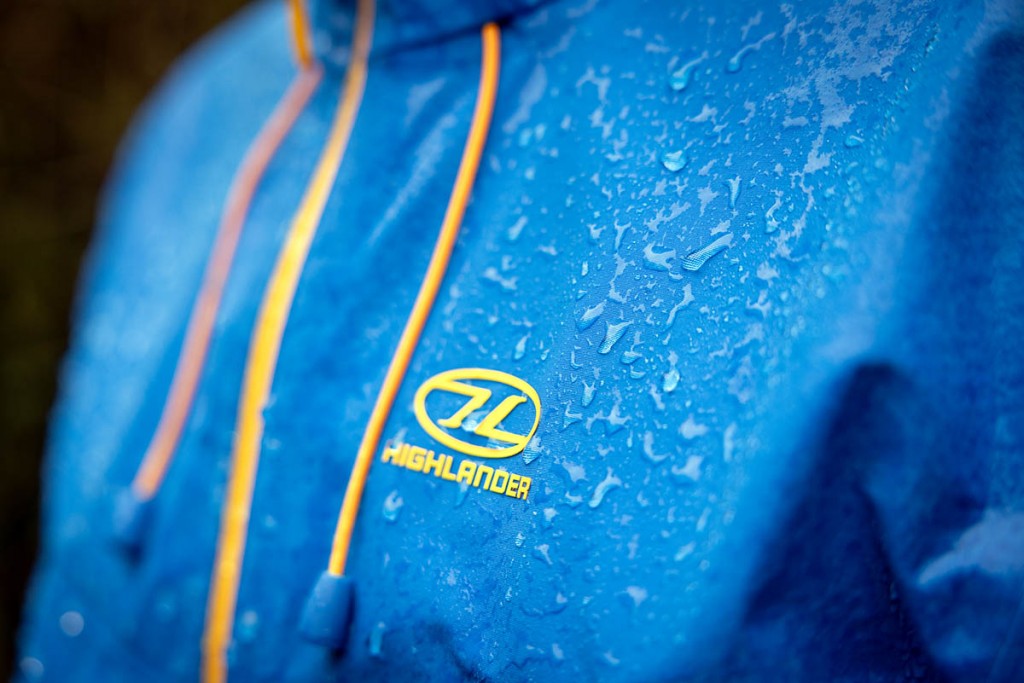
The Highlander jacket is among good choices for those on a tight budget. Photo: Bob Smith Photography
For the many who can’t afford to spend £300 or more on a jacket, two obvious contenders are the Highlander and H&M garments. The former is a full-on winter waterproof offering the necessary features and performance to keep you protected on the mountains, including the munros. H&M’s foray into outdoors design wins the award for lowest price and again kept me protected in some serious weather on the hills.
The Jack Wolfskin jacket is a nice design but it’s hard to justify its price at the top of the table.
- All the jackets were supplied to grough by the brands. Suggested prices were correct at the time of writing.
